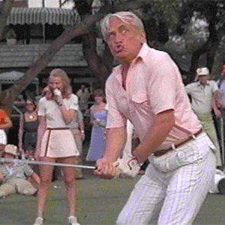In his book The Principles Behind the Rules of Golf, Richard Tufts proclaims that you should strive to “”¦play the ball as it lies and the course as you find it.” When playing in the Rocky Mountain springtime we should all keep this in mind, especially with the wet May we had here in Colorado.
One of the most frequent questions we get at our early CGA championships and qualifiers is, “Are we playing the ball down today?” This refers to the local rule of “preferred lies,” aka Judge Smails’ “winter rules.” There are a number of factors I consider when determining whether this local rule should be used in a competition.
The very first one I look at is what the overall condition of the course is. Early in the season golf courses are still trying to recover from the winter, so they are not typically in their peak shape. You are most likely going to get some thin grassed lies throughout the course, but this is not considered abnormal. In these circumstances the course will be playing the same for everyone and preferred lies should not be used. In fact, the same is true when a course has received a significant amount of rain in June or August. Yes, there is the opportunity for mud to adhere to the golf ball, but this is true for everyone and is part of “playing the ball as it lies and the course as you find it.” Some people feel that this brings luck into play, but I would say that in every round of golf played there is some luck involved, and I would argue that mud on a golf ball only helps to identify the more skilled players.
There are a few other factors that should be taken into consideration when deciding whether to use “winter rules.” I must determine what, if any, additional damage is the course going to receive when preferred lies are used. For example; if a player’s ball is lying on a thinly grassed area and they are allowed to move it to a thick, green tuft of grass, are they are going to damage a recovering course by taking a divot out of the healthier area? I must also consider what effect winter rules will have on a player’s Handicap Index. If a player is allowed to move their ball to a better lie throughout their round, posting this tournament score will effectively lower their handicap making it difficult to compete with other golfers who are not using this local rule.
Finally, I must determine the effect this local rule will have on the pace of play. If a player is allowed to lift, clean and place their ball on every shot in the fairway, this will slow down a round considerably. When conducting a state championship, managing the pace of play is one of our greatest priorities and challenges.
Now, there are some instances when “winter rules” should be used, and even then they should be limited to only one or two holes if possible. In my eight years at the CGA I can only recall one instance where we have used the “preferred lies” local rule. During our Stroke Play Championship the entire golf course was in immaculate shape with the exception of one fairway was considerably damaged by birds searching for worms. We used the local rule allowing for preferred lies in the fairway on that hole only, allowing players to lift, clean and place their ball anywhere in a close-mown area (fairway height or less).
According to former USGA Senior Director of Rules and Competitions Tom Meeks, “We do not play golf in a bubble.” This means we have to accept and adapt to the conditions that are present during each round. In Judge Smails’ case, his playing by “winter rules” on a dry, sunny day didn’t help him in the end. In fact, Moose and Rocco had to help him find his wallet!


